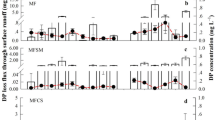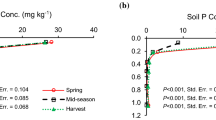Abstract
Two crop rotations dominated by spring cereals and grass/clover leys on a clay soil were studied over 2 years with respect to nitrogen (N) and phosphorus (P) leaching associated with pig or dairy slurry application in April, June and October. Leaching losses of total N (TN), total P (TP), nitrate-N and dissolved reactive P (DRP) were determined in separately tile-drained field plots (four replicates). Mean annual DRP leaching after October application of dairy slurry (17 kg P ha−1) to growing grass/clover was 0.37 kg ha−1. It was significantly higher than after October application of pig slurry (13 kg ha−1) following spring cereals (0.16 kg ha−1) and than in the unfertilised control (0.07 kg P ha−1). The proportion of DRP in TP in drainage water from the grass/clover crop rotation (35 %) was higher than from the spring cereal rotation (25 %) and the control (14 %). The grass/clover rotation proved to be very robust with respect to N leaching, with mean TN leaching of 10.5 kg ha−1 year−1 compared with 19.2 kg ha−1 year−1 from the cereal crop rotation. Pig slurry application after cereals in October resulted in TN leaching of 25.7 kg ha−1 compared with 7.0 kg ha−1 year−1 after application to grass/clover in October and 19.1 kg ha−1 year−1 after application to spring cereals in April. In conclusion, these results show that crop rotations dominated by forage leys need special attention with respect to DRP leaching and that slurry application should be avoided during wet conditions or combined with methods to increase adsorption of P to soil particles.




Similar content being viewed by others
References
Andersson H, Bergström L, Djodjic F, Ulén B, Kirchmann H (2013) Topsoil and subsoil properties influence phosphorus leaching from four agricultural soils. J Environ Qual 42:455–463
APHA (1985) Standard methods for the examination of water and waste water. American Public Health Association, New York
Beckwith CP, Cooper J, Smith KA, Shepherd MA (1998) Nitrate leaching loss following application of organic manures to sandy soils in arable cropping. I. Effects of application time, manure type, overwinter crop cover and nitrification inhibition. Soil Use Manag 14:123–130
Bergström LF, Shirmohammadi A (1999) Areal extent of preferential flow with profile depth in sand and clay monoliths. J Soil Contam 8(6):637–651
Börling K, Ottabong E, Barberis E (2001) Phosphorus sorption in relation to soil properties in some cultivated Swedish soils. Nutr Cycl Agroecosyst 59:39–46
Börling K, Ottabong E, Barberis E (2004) Soil variables for predicting phosphorus release in Swedish noncalcareous soils. J Environ Qual 33:99–106
Carpenter SR, Caraco NF, Correll DL, Howarth RW, Sharpley AN, Smith VH (1998) Nonpoint pollution of surface waters with phosphorus and nitrogen. Ecol Appl 8:559–568
Culley JLB, Bolton EF, Bernyk V (1983) Suspended solids and phosphorus loads from a clay soil: I. Plot studies. J Environ Qual 12(4):493–498
Dilz K, Postmus J, Prins WH (1990) Residual effects of long-term applications of farmyard manure to silage maize: a case study to test the Sluijsmans–Kolenbrander model. Fertil Res 26:249–252
Djodjic F, Bergström L, Ulén B, Shirmohammadi A (1999) Mode of transport of surface-applied phosphorus-33 through a clay and sandy soil. J Environ Qual 28:1273–1282
Djodjic F, Bergström L, Ulén B (2002) Phosphorus losses from a structured clay soil in relation to tillage practices. Soil Use Manag 18:79–83
Djuurhus J, Olsen P (1997) Nitrate leaching after cut grass/clover leys as affected by time of ploughing. Soil Use Manag 13:61–67
Egnér H, Riehm H, Domingo WR (1960) Untersuchungen über die chemische Bodenanalyse als Grundlage für die Beurteilung des Nährstoffzustandes der Boden, 26th edn. II Chemische Extraktionsmethoden zur Phosphor- und Kaliumbestimmung. Kunlinga Landboukshogskolans Annaler, German, pp 199–215
Francis GS, Haynes RJ, Sparling GP, Ross DJ, Williams PH (1992) Nitrogen mineralization, nitrate leaching and crop growth following cultivation of a temporary leguminous pasture in autumn and winter. Fertil Res 33:59–70
Glæsner N, Kjaergaard C, Rubæk GH, Magid J (2011) Interactions between soil texture and placement of dairy slurry application: II, leaching of phosphorus forms. J Environ Qual 40:344–351
Heckrath G, Brookes PC, Poulton PR, Goulding KWT (1995) Phosphorus leaching from soils containing different phosphorus concentrations in the Broadbalk experiment. J Environ Qual 24:904–910
Hesketh N, Brookes PC (2000) Development of an indicator for risk of phosphorus leaching. J Environ Qual 29:105–110
Hinsinger P (2001) Bioavailability of soil inorganic P in the rhizosphere as affected by root-induced chemical changes: a review. Plant Soil 237:173–195
Hooda PS, Rendell AR, Edwards AC, Withers PJA, Aitken MN, Truesdale VW (2000) Relating soil phosphorus indices to potential phosphorus release to water. J Environ Qual 29:1166–1171
Jackson DR, Smith KA (1997) Animal manure slurries as a source of nitrogen for cereals; effect of application time on efficiency. Soil Use Manag 13:75–81
Jones DL (1998) Organic acids in the rhizosphere—a critical review. Plant Soil 205:25–44
Karlsson I, Håkansson A (1983) Studies of soil profiles of Swedish arable soils. Report 133. Division of Agricultural Hydrotechnics, Department of Soil Sciences. Swedish University of Agricultural Sciences (in Swedish)
Kirsten WJ, Hesselius GU (1983) Rapid automatic, high capacity Dumas determination of nitrogen. Microchem J 28:529–547
KLS (1965) Kungliga Lantbruksstyrelsens kungörelse med bestämmelser för under sökning av jord vid statens lantbrukskemiska kontrollanstalt och lantbrukskemisk kontrollstation och lantbrukskemisk station med av staten fastställda stadgar. Kungliga Lantbruksstyrelsens kungörelser 1 (in Swedish)
Lewan E (1993) Evaporation and discharge from arable land with cropped or bare soils during winter: measurements and simulations. Agric For Meteorol 64:131–159
Lindén B, Wallgren B (1993) Nitrogen mineralization after leys ploughed in early or late autumn. Swed J Agric Res 23:77–89
Littell RC, Milliken GA, Stroup WW, Wolfinger RD, Schabenberger O (2006) SAS for mixed models, 2nd edn. SAS Institute Inc., Cary
Liu J, Aronsson H, Blombäck K, Persson K, Bergström L (2012a) Long-term measurements and model simulations of phosphorus leaching from a manured sandy soil. J Soil Water Conserv 67(2):101–110
Liu J, Aronsson H, Bergström L, Sharpley A (2012b) Phosphorus leaching from loamy sand and clay loam topsoils after application of pig slurry. SpringerPlus 1:53. http://www.springerplus.com/content/pdf/2193-1801-1-53.pdf
Liu J, Khalaf R, Ulén B, Bergkvist G (2013) Potential phosphorus release from catch crop shoots and roots after freezing–thawing. Plant Soil 371:543–557
Lundekvam H, Skøien S (1998) Soil erosion in Norway. An overview of measures from soil loss plots. Soil Use Manag 14:84–89
Meissner R, Rupp H, Seeger J, Schonert P (1995) Influence of mineral fertilizers and different soil types on nutrient leaching: results of lysimeter studies in East Germany. Land Degrad Rehabil 6:163–170
Møller Hansen E, Djurhuus J (1997) Nitrate leaching as influenced by soil tillage and catch crop. Soil Tillage Res 41:203–219
Munch JC, Velthof GL (2007) Denitrification and agriculture. In: Bothe H, Ferguson SJ, Newton WE (eds) Biology of the nitrogen cycle. Elsevier, Amsterdam, pp 331–341
Neumann A, Torstensson G, Aronsson H (2011) Losses of nitrogen and phosphorus via the drainage system from organic crop rotations with and without livestock on a clay soil in south-west Sweden. Organ Agric 1:217–229
Olesen JE, Askegaard M, Rasmussen IA (2000) Design of an organic farming crop rotation experiment. Acta Agric Scand Sect B Soil Plant Sci 50:13–21
Riddle MU, Bergström L (2013) Phosphorus leaching from two soils with catch crops exposed to freeze–thaw cycles. Agron J 105(3):803–811
Schelde K, de Jonge LW, Kjaergaard C, Laegdsmand M, Rubaek G (2006) Effects of manure application and plowing on transport of colloids and phosphorus to tile drains. Vadose Zone J 5:445–458
Schoumans OF, Chardon WJ, Bechmann ME, Gascuel-Odoux C, Hofman G, Kronvang B, Rubæk GH, Ulén B, Dorioz JM (2014) Mitigation options to reduce phosphorus losses from the agricultural sector and improve surface water quality: a review. Sci Total Environ 468–469:1255–1266
Sharpley AN, McDowell RW, Kleinman PJA (2001) Phosphorus loss from land to water: integrating agricultural and environmental management. Plant Soil 237:287–307
Sims JT, Simard RR, Joern BC (1998) Phosphorus losses in agricultural drainage: historical perspective and current research. J Environ Qual 27:277–293
Sommer SG, Hutchings NJ (2001) Ammonia emissions from field applied manure and its reduction—invited paper. Eur J Agron 15:1–15
Sommer SB, Jensen LS, Clausen SB, Søgaard HT (2006) Ammonia volatilization from surface-applied livestock slurry as affected by slurry composition and slurry infiltration depth. J Agric Sci 144(3):229–235
Stenberg M, Aronsson H, Lindén B, Rydberg T, Gustafson A (1999) Soil mineral nitrogen and nitrate leaching losses in soil tillage systems combined with a catch crop. Soil Tillage Res 50:115–125
Thorup-Kristensen K, Dresbøll DB (2010) Incorporation time of nitrogen catch crops influences the N effect for the succeeding crop. Soil Use Manag 26:27–35
Toor GS, Condron LM, Di HJ, Cameron KC, Cade-Menun BJ (2003) Characterization of organic phosphorus in leachate from a grassland soil. Soil Biol Biochem 35:1317–1323
Toor GS, Condron LM, Cade-Menun BJ, Di HJ, Cameron KC (2005) Preferential phosphorus leaching from an irrigated grassland soil. Eur J Soil Sci 56:155–167
Torstensson G (1998) Nitrogen delivery and utilization by subsequent crops after incorporation of leys with different plant composition. Biol Agric Hortic 16:129–143
Torstensson G, Aronsson H (2000) Nitrogen leaching and crop availability in manured catch crop systems. Nutr Cycl Agroecosyst 56(2):139–152
Turtola E, Jaakkola A (1995) Loss of phosphorus by surface runoff and leaching from a heavy clay soil under barley and grass ley in Finland. Acta Agric Scand Sect B Soil Plant Sci 45:159–165
Ulén B (2006) A simplified risk assessment for losses of dissolved reactive phosphorus through drainage pipes from agriculture soils. Acta Agric Scand Sect B Soil Plant Sci 56:307–314
Ulén B, Aronsson H, Torstensson G, Mattsson L (2005) Nutrient turnover and risk of waterborne phosphorus emissions in crop rotations on a clay soil in south-west Sweden. Soil Use Manag 21:221–230
Ulén B, Aronsson H, Bechmann M, Krogstad T, Øygarden L, Stenberg M (2010) Soil tillage measures to control phosphorus loss and potential side-effects: a Scandinavian review. Soil Use Manag 26:94–107
Ulén B, Eriksson AK, Etana A (2013) Nutrient leaching from clay soil moniliths with variable past manure inputs. J Plant Nutr Soil Sci 176(6):883–891
Van Es HM, Schindelbeck RR, Jokela WE (2004) Effect of manure application timing, crop and soil type on phosphorus leaching. J Environ Qual 33:1070–1080
Vandré R, Clemens J (1997) Studies on the relationship between slurry pH, volatilization processes and the influence of acidifying additives. Nutr Cycl Agroecosyst 47:157–165
Wallgren B, Lindén B (1994) Effects of catch crops and ploughing times on soil mineral nitrogen. Swed J Agric Res 24(2):67–75
Acknowledgments
This study received financial support from the Swedish Farmers’ Foundation of Agricultural Research.
Author information
Authors and Affiliations
Corresponding author
Rights and permissions
About this article
Cite this article
Aronsson, H., Liu, J., Ekre, E. et al. Effects of pig and dairy slurry application on N and P leaching from crop rotations with spring cereals and forage leys. Nutr Cycl Agroecosyst 98, 281–293 (2014). https://doi.org/10.1007/s10705-014-9611-3
Received:
Accepted:
Published:
Issue Date:
DOI: https://doi.org/10.1007/s10705-014-9611-3




